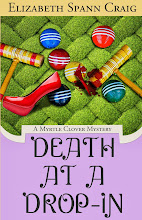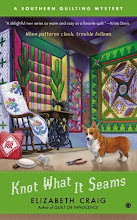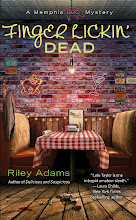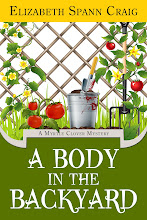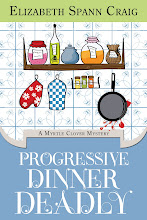by Elizabeth S. Craig, @elizabethscraig
Twitterific is a compilation of all the writing links I shared the previous week.
The links are fed into the Writer’s Knowledge Base  search engine (developed by writer and software engineer Mike Fleming) which has over 16,000 free articles on writing-related topics. Sign up for our free newsletter for monthly writing tips and interviews with top contributors to the WKB or like us on Facebook.
search engine (developed by writer and software engineer Mike Fleming) which has over 16,000 free articles on writing-related topics. Sign up for our free newsletter for monthly writing tips and interviews with top contributors to the WKB or like us on Facebook.
Have a great week!
Don't wait for your muse: http://bit.ly/LeDprR @LisaCron
Introducing your protagonist--the importance of 1st impressions: http://bit.ly/LeDJH1 @Janice_Hardy @dpeterfreund
When You Feel Lost in Creative Work & Business: http://bit.ly/LeDPyl @JeffreyDavis108
A tax-related post for self-pubbed non-US authors: http://bit.ly/LeEDTV @nickdaws
Passive Vs. Active Voice: http://bit.ly/LeEOyB @greyhausagency
1 writer's 10 year vantage point on stinging reviews: http://bit.ly/LeFWCe @blurbisaverb
The theme of anarchy in crime fiction: http://bit.ly/KCLEjG @mkinberg
The Writing Part is Easy: A Publishing Story: http://bit.ly/LeG6cV @karensuebell @womenwriters
Writing Is a War & Your Story Is a Trojan Horse: http://bit.ly/LeGbNF @fuelyourwriting
An Agent Reports What Editors Have Bought Recently for Women's Fic and Literary: http://bit.ly/LeGh7T
Reminder to publishers--the product is the story, not the physical book: http://bit.ly/MCRJrE @Bob_Mayer @JenTalty @Porter_Anderson
3 Reasons to Upgrade to a Premium WordPress Theme: http://bit.ly/MVPrEO @joebunting
Creativity is never a single act: http://bit.ly/MVPCzV @CreativityPost
Cavalcade Of Literary Jerks: http://bit.ly/MVPHDU @litreactor
Tolkien did it better than Jackson--10 things writers can learn in the process: http://bit.ly/MVQ9C1 @AlmaAlexander
Worldbuilding for Short Stories: http://bit.ly/MVQoNs @juliettewade
Your Writing Repertoire: The Long and Short of It: http://bit.ly/MVQvIV @writeangleblog @JLeaLopez
Getting Published: 5 Ways To Increase Your Chances Of Beating The Odds: http://bit.ly/MVQJQ5
Taking the Mystery Out of Query Letters: http://bit.ly/MeBBQz @rachellegardner
Theme--the heart of your story: http://bit.ly/MeBHb1 @livewritethrive
Pushing Through the Middle of Your Book: http://bit.ly/MeBNiP @TaliaVance
E is for Epilogue: http://bit.ly/MeC8lw @annerooney
2 Most Common Reasons for Hiding Character Motivation: http://bit.ly/MeCkRY @SharlaWrites
Strategies for writers facing summertime schedule upheaval: http://bit.ly/MeCusq @CherylRWrites
Why Writers Should Read-Inner Voice: http://bit.ly/MeCHMm
103 Synonyms for Anger or Angry: http://bit.ly/MeCTLz @Vigorio
Notes to the First-Time Novelist: http://bit.ly/MeD3T2 @nbakopoulos
How Much Does It Really Cost to Self-Publish? http://bit.ly/MeDahF
Using archaeology, myth, mysteries & history for writing inspiration: enigma and the iron thunderbolt: http://bit.ly/MAH8B0 @genelempp
How to Break Out of a Creative Rut: http://bit.ly/MAHeZn @copyblogger
Signs Your Story Has Too Many Characters: http://bit.ly/MAHqHX @KMWeiland
Conquering the Cliche: http://bit.ly/MAHK9J @AshKrafton
Bringing an old manuscript back to life, and to print: http://bit.ly/MZbb2t @PeteAbela @Christi_Craig
2 Questions to Develop Plot: What If? and What Next? http://bit.ly/MAHTdk @FictionNotes
You Have A Request Or You Get "THE CALL" - Now What? http://bit.ly/N9y1rU @greyhausagency
The Secret to Show, Don't Tell: http://bit.ly/N9y72L @joebunting
New Book Buyers are Hiding Inside Your Manuscript: http://bit.ly/N9yr1s @rileymagnus
How to Influence Editors in a Way That 90% of Other Writers Don't: http://bit.ly/N9yD0I @janefriedman @rachellegardner
Author Websites, Branding And CopyWriting: http://bit.ly/N9yMBd @thecreativepenn @menwithpens
Weaving humor into your worldbuilding: http://bit.ly/N9z4rR @AmyJRoseDavis
How to become an ebook superstar: http://bit.ly/N9zApK @patrick_barkham
Making Comparisons—Simile and Metaphor in Fiction: http://bit.ly/N9zGxJ @noveleditor
Bookstores in today's publishing climate: the good, the bad, the ugly: http://bit.ly/N9zPkD @behlerpublish
Freelancers--10 ways to use Pinterest to find a new job: http://bit.ly/N9zYV2 @MichelleRafter @secondact
Writers: Get Inspired And Motivated By The Classics: http://bit.ly/N9AkLu @KarenBerner
The Path To Publication: Delusions of Grandeur: http://bit.ly/NHqMdd @RobWHart
Today's Publishing--The End of The World as We Know It? http://bit.ly/NHrp6D @KristineRusch
Passive Writing: http://bit.ly/NHryXw @NovelRocket
How to have your novel made into an audio book: http://bit.ly/NHs7k4 @thewritingbomb
The Source: A Look At Inspiration: http://bit.ly/NHss6x @sandranorval
5 Ways Writers Get Lazy: http://bit.ly/NHszyJ @jodyhedlund
On Characters and Conflict: http://bit.ly/NHtejJ @kalayna
Common issues that get in the way of crafting a great short story: http://bit.ly/NHtxuY @WriterUnboxed
Choose harmony over balance in your writing life: http://bit.ly/NHtKhL @joebunting
When is your book done? http://bit.ly/NHtRdb @robwhart
How to Make the Most of a Scene: http://bit.ly/NHu3sR @jamigold
7 Steps for Plotting and Pacing: http://bit.ly/KYU9QN @MaureenLynas
Pixar story rules: http://bit.ly/Mjn6uZ @lawnrocket
riting At Night: The Top 10 Challenges Writers Experience & How to Overcome Them: http://bit.ly/KYUHWY @AineGreaney
5 Ways to Get More Involved in the Blogging World: http://bit.ly/KYUXVV
Enhanced ebooks are bad for children finds US study: http://bit.ly/KYV4AM @guardianbooks
The Path To Publication: Delusions of Grandeur: http://bit.ly/NHqMdd @RobWHart
You Have A Request Or You Get "The Call" - Now What? http://bit.ly/N9y1rU @greyhausagency
5 rules for social media engagement: http://bit.ly/MqxBg2 @duolit
Typography in Kindle: http://bit.ly/MqxK2U @JFBookman
5 Ways to Find the Right Publisher for Your Book: http://bit.ly/MqxRM6 @cherylrwrites
How One Introverted Author Successfully Markets His Work: http://bit.ly/MqxYY5 @janefriedman
A Short Quiz About Partial Quotations: http://bit.ly/Mqy8P6 @writing_tips
1 writer would like fewer social media gimmicks: http://bit.ly/MqyjKm @jillkemerer
5 Commandments of Creativity: http://bit.ly/MqyxRC @susannebrent
9 tips for writing a novel: http://bit.ly/MqyYLA @novelrocket
Characters brought back from the brink: http://bit.ly/Mqz4ms @guardianbooks
The Editorial Phone Call: http://bit.ly/Mqz7yR @writeangleblog @bigblackcat97
Are You Trying to Write a Well-Written Book or Tell a Great Story? http://bit.ly/Mqzmd5 @janice_hardy
10 Lessons Writers Can Learn From Fifty Shades Of Grey: http://bit.ly/PuoNpM @mshannabrooks
Choosing between big and small presses: http://bit.ly/Puq0xm @behlerpublish
The summer reading flowchart: http://bit.ly/PuqXWl @galleycat
How Many POVs is Too Many? http://bit.ly/PuraJb @eMergentPublish
Elements of fantasy--owls: http://bit.ly/PurxUb @fantasyfaction
A Writer's Guide to Starting from Scratch: http://bit.ly/PuAddb @krissybrady
Writing from Both Sides of the Brain: http://bit.ly/PuAk8x
Hunger Games--What the Story Teaches Writers: http://bit.ly/PuC8ye @storyfix
The importance of editing your book: http://bit.ly/PuD2e3 @rebeccaberto
How to Spot and Fix Non-Reactive and Over-Reactive Characters: http://bit.ly/PuDcCj @KMWeiland
The agent-author relationship: http://bit.ly/PuDZ65 @literaticat
Hooking and Orienting the Reader in the Opening Scene: http://bit.ly/PuEcGq @Janice_Hardy
You should free write even if you're not a writer: http://bit.ly/PuFfX3 @tannerc
"Rules" and making them up: http://bit.ly/PuFqBM @theresastevens
Plot possibilities to get your mind moving through writer's block: http://bit.ly/PuFMYX
Rewriting the publishing dream: http://bit.ly/PuLyK3
1 writer's process for creating a 1st draft: http://bit.ly/PuM8Yh
Repetition – a two-ended hammer: http://bit.ly/PuMCxK @dirtywhitecandy
The Bash-Through Draft: http://bit.ly/PuN1Af @AlexSokoloff
The problem with putting this in your query: "My book is suitable for children of all ages": http://bit.ly/KNvHs8 @nicolamorgan
Fight Scenes: The Waltz of Death: http://bit.ly/KNvMvY @fictionnotes
8 Steps Needed Before Submitting Your Manuscript: http://bit.ly/KNvRQr @karencv
On writers' concerns over plot theft: http://bit.ly/KNvZPP @annerallen
5 Tips for Turning Real Life into Fiction: http://bit.ly/KNwM3k @writeitsideways
Avoid Time Sinks: Ways to be a More Productive Writer: http://bit.ly/KNwXvj @janice_hardy
3 tips for staying focused on your writing: http://bit.ly/KNx2PA @jeffgoins
Do Your Characters Make Enough Mistakes? http://bit.ly/KNGiTP @Ava_Jae
3 Unappealing (But Effective) Ways to Make Time to Write: http://bit.ly/KNGnqB @krissybrady
Why Boredom Is Good for Your Creativity: http://bit.ly/KNGq5K @markmcguinness
Precise wording can bring your book to the next level: http://bit.ly/KNGB16 @4YALit
5 Ways to Get Out of the Comfort Zone and Become a Stronger Writer: http://bit.ly/KNGEtI @kristenlambTX
How To Create A Meaningful (Not Promotional) Book Launch: http://bit.ly/KNH03v @JonathanFields @danblank
Waiting For A Story To Get Going: http://bit.ly/KNH5UO @mooderino
5 YA Marketing Tips from Publishing Professionals: http://bit.ly/KNH9Ef @galleycat
Worldbuilding with Horses: Urban Horsekeeping: http://bit.ly/KNHeI7 @bookviewcafe
5 Book Review Blogs: http://bit.ly/KNHeaW @woodwardkaren
Story structure of a heist movie in 15 sentences: http://bit.ly/KNHkPR @laurapauling
The Difference Between Brand and Platform and Why Every Author Needs Both: http://bit.ly/KzTEC3 @TheLitCoach
Good Books Are Worth the Wait: http://bit.ly/KzTElr @passivevoiceblg
Your Punctuation Personality Type: http://bit.ly/KzTN8x @LeahPetersen @BryanThomasS
How to Balance Your Blogging Tasks Without Going Crazy: http://bit.ly/KzTPx3 @Pushingsocial
Plot vs. Character: Leaving Room for Magic: http://bit.ly/KzTXww @diymfa @4YALit
Personal interactions reveal character: http://bit.ly/KzU1fO @juliettewade
Four Elements Of a Solid Story Concept: http://bit.ly/KzU5fv @writersdigest
Using Pinterest as a Reader, Writer, and Author: http://bit.ly/KzU8rQ @lkblackburne
How a Debut Author Used His Old College to Find New Readers: http://bit.ly/KzUa2N @galleycat
Setting International Prices for Ebooks: http://bit.ly/KzUdMa @passivevoiceblg
5 Points To Ponder Before You Self Publish: http://bit.ly/KWELqb @woodwardkaren
A look at present participial phrases: http://bit.ly/KWEOSI @theresastevens
5 ways to keep focused on your writing: http://bit.ly/KWF4RN @lynnettebonner
What will the global e-book market look like by 2016? http://bit.ly/KWFgjN @laurahazardowen
How to write comics: http://bit.ly/KWFl7b @litreactor
Why aren't women more visible in the digital publishing debate? http://bit.ly/KWFsQc @Porter_Anderson @samatlounge
Agency pricing and the Dept. of Justice: http://bit.ly/KWG1JE @Jane_L @Porter_Anderson @JayLLevine @JDGsaid
Agents in Transition--Curtis Brown offering writing courses: http://bit.ly/KWHcsP @Porter_Anderson
Booktango and the Future of DIY E-book Publishing: http://bit.ly/MAHUfR @pubperspectives
The Secret Myth of Traditional Publishing: http://bit.ly/MAImdP @deanwesleysmith
Creating Memorable Secondary Characters: http://bit.ly/MAIqdv
 A Little Tip That Can Make a Good Story Great
A Little Tip That Can Make a Good Story Great Dr John Yeoman, PhD Creative Writing, judges the Writers’ Village story competition and is a tutor in creative writing at a UK university. His free 14-part course in writing fiction for the commercial market can be found here.
Dr John Yeoman, PhD Creative Writing, judges the Writers’ Village story competition and is a tutor in creative writing at a UK university. His free 14-part course in writing fiction for the commercial market can be found here.






![Girl on a red carpet--Felice Casorati (1883-1963)[2] Girl on a red carpet--Felice Casorati (1883-1963)[2]](http://lh5.ggpht.com/-TMc9swtZ9Hw/T-EFPN1HRfI/AAAAAAAAEvA/bAvdc3yxqv0/Girl%252520on%252520a%252520red%252520carpet--Felice%252520Casorati%252520%2525281883-1963%252529%25255B2%25255D_thumb.jpg?imgmax=800)








